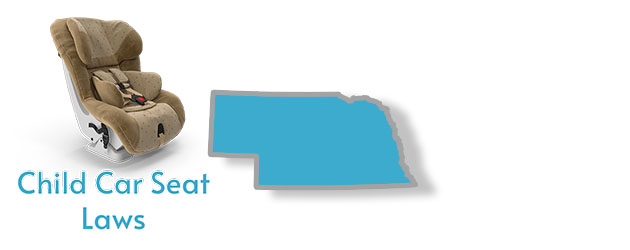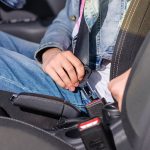
- Children are required to ride on rear-facing seats from birth until age 2 or until they exceed the maximum weight and height limits of the seat.
- Once children reach age 2 or exceed the rear-facing seat requirements, they can graduate to forward-facing seats.
- Children who have outgrown forward-facing seats are required to ride on booster seats until they are 8 years old.
- The law requires children 8 years or younger to ride in the back seat.
What Are the Height and Weight Requirements for Car Seats in Nebraska?

Children are required to ride in rear-facing seats from birth until age 2 or until they exceed the maximum weight and height limits of the seat.
Once children reach age 2 or exceed the rear-facing seat requirements, they can graduate to forward-facing seats.
Children who have outgrown forward-facing seats are required to ride on booster seats until they are 8 years old.
The law requires children 8 years or younger to ride in the back seat.
What Are the Rear Facing Car Seat Laws in Nebraska?

According to Nebraska’s new Child Passenger Safety Law (effective since January 1, 2019), children are required to ride on rear-facing seats from birth until age 2 or until they exceed the maximum weight and height limits set by the car seat’s manufacturer.
Typically, newborns usually ride on infant-only seats until they are at least 1 year, and then switch to convertible seats, which allow them to stay rear-facing for a longer period, because of their higher weight limits (up to 40 pounds). As a result, children in convertibles can safely remain rear-facing until age 4, depending on their growth rate.
Rear-facing facing seats usually come with harness straps that should be used to fasten the child in place. These are designed to support the baby’s head and neck and limit movement during a crash. The seat should be secured in the back seat according to the manufacturer’s instructions.
What Are the Forward Facing Car Seat Laws in Nebraska?

Once children reach age 2 or exceed the rear-facing seat requirements, they can graduate to forward-facing seats. Parents can buy forward-facing only seats or turn their convertible seats to face forward if they have one. A seat with a five-point harness should be used to improve safety. The harness straps should be reasonably tight at or above the child’s collarbone. No more than one finger should fit in between the collarbone and strap. The seat should be tightly installed (less than 1-inch of movement) in the back seat and away from an active airbag.
Children should remain forward-facing until they reach the top weight and height limits set by the manufacturer. While the recommended age to remain forward-facing is until age 4, some seats can support up to 65 pounds, so this means children can safely remain forward-facing until age 7.
What Are the Booster Seat Laws in Nebraska?

Nebraska law requires children who have outgrown forward-facing seats to ride to on federally approved belt-positioning booster seats until they are 8 years old. Booster seats can be used together with a lap-shoulder belt or latch system. Do not use lap-only belts. A booster seat allows children to ride using an adult seat belt. It increases their height in the back seat so that the shoulder belt lies across the chest area without riding up on the neck, and the lap belt lies flat across the upper thighs (not the stomach). If your car does not have a headrest to support your child’s head, you can opt for a high-back booster seat. Keep your child in a booster seat until your child exceeds the manufacturer’s height and weight guidelines.
While the state allows you to transition your child to seat belts after age 8, most experts agree you should only do so after they reach a height of 4’9’’. This is because safety belts are designed with the size of an average adult in mind, so kids shorter than 4’9’’ may not be comfortable in seat belts. Before graduating your child to the next restraint device, ensure that he or she can comfortably sit against the back seat without slouching and with knees bent at the edge of the seat, with feet touching the floor.
When Can a Child Use the Front Seat in Nebraska?

The law requires children 8 years or younger to ride in the back seat as long as there is a back seat with seat belts. Exceptions apply when the car has no back seat or when all the seat belts in the back seat are occupied by other children 8 years or younger. However, before putting a child in the front seat, you should turn off the airbag to avoid injury to the child in case it is deployed. Also, most experts recommend children should ride in the back seat until age 13.
Is it Illegal to Leave a Child Inside a Vehicle in Nebraska?
It is illegal to leave a child younger than 6 years unsupervised inside a vehicle.
Is it Illegal to Smoke in a Car With a Child in Nebraska?
No law makes it illegal to smoke in a car with child passengers. Although it is not recommended to smoke with a child in the car.
Are Car Seats Required in Taxis in Nebraska?
What is the Car Seat Replacement Law in Nebraska?
No law covers the replacement of car seats. However, the National Highway Traffic Safety Administration recommends replacing your car seat after a moderate or severe car crash. Seats also have expiry dates (usually 6 years), so be sure to replace yours when they expire.
Car Seat Law on Children 8-18 years in Nebraska
Children in this age range are required by law to ride while wearing a seat belt or be secured in a booster seat.
More Nebraska Laws
